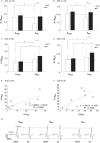Spinal plasticity with motor imagery practice
- PMID: 30417924
- PMCID: PMC6355716
- DOI: 10.1113/JP276694
Spinal plasticity with motor imagery practice
Abstract
Key points: While a consensus has now been reached on the effect of motor imagery (MI) - the mental simulation of an action - on motor cortical areas, less is known about its impact on spinal structures. The current study, using H-reflex conditioning paradigms, examined the effect of a 20 min MI practice on several spinal mechanisms of the plantar flexor muscles. We observed modulations of spinal presynaptic circuitry while imagining, which was even more pronounced following an acute session of MI practice. We suggested that the small cortical output generated during MI may reach specific spinal circuits and that repeating MI may increase the sensitivity of the spinal cord to its effects. The short-term plasticity induced by MI practice may include spinal network modulation in addition to cortical reorganization.
Abstract: Kinesthetic motor imagery (MI) is the mental simulation of a movement with its sensory consequences but without its concomitant execution. While the effect of MI practice on cortical areas is well known, its influence on spinal circuitry remains unclear. Here, we assessed plastic changes in spinal structures following an acute MI practice. Thirteen young healthy participants accomplished two experimental sessions: a 20 min MI training consisting of four blocks of 25 imagined maximal isometric plantar flexions, and a 20 min rest (control session). The level of spinal presynaptic inhibition was assessed by conditioning the triceps surae spinal H-reflex with two methods: (i) the stimulation of the common peroneal nerve that induced D1 presynaptic inhibition (HPSI response), and (ii) the stimulation of the femoral nerve that induced heteronymous Ia facilitation (HFAC response). We then compared the effects of MI on unconditioned (HTEST ) and conditioned (HPSI and HFAC ) responses before, immediately after and 10 min after the 20 min session. After resting for 20 min, no changes were observed on the recorded parameters. After MI practice, the amplitude of rest HTEST was unchanged, while HPSI and HFAC significantly increased, showing a reduction of presynaptic inhibition with no impact on the afferent-motoneuronal synapse. The current results revealed the acute effect of MI practice on baseline spinal presynaptic inhibition, increasing the sensitivity of the spinal circuitry to MI. These findings will help in understanding the mechanisms of neural plasticity following chronic practice.
Keywords: D1 presynaptic inhibition; H-reflex; heteronymous Ia facilitation; soleus; triceps surae.
© 2018 The Authors. The Journal of Physiology © 2018 The Physiological Society.
Figures






References
-
- Achache V, Roche N, Lamy J‐C, Boakye M, Lackmy A, Gastal A, Quentin V & Katz R (2010). Transmission within several spinal pathways in adults with cerebral palsy. Brain 133, 1470–1483. - PubMed
-
- Aoyama T & Kaneko F (2011). The effect of motor imagery on gain modulation of the spinal reflex. Brain Res 1372, 41–48. - PubMed
-
- Baudry S & Enoka RM (2009). Influence of load type on presynaptic modulation of Ia afferent input onto two synergist muscles. Exp Brain Res 199, 83–88. - PubMed
-
- Bergmans J, Delwaide PJ & Gadea‐Ciria M (1978). Short‐latency effects of low‐threshold muscular afferent fibers on different motoneuronal pools of the lower limb in man. Exp Neurol 60, 380–385. - PubMed
Publication types
MeSH terms
LinkOut - more resources
Full Text Sources

